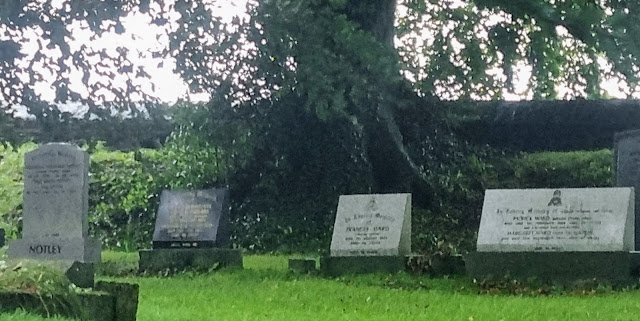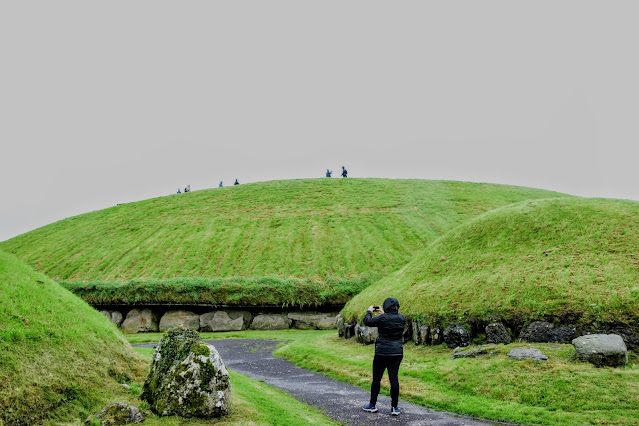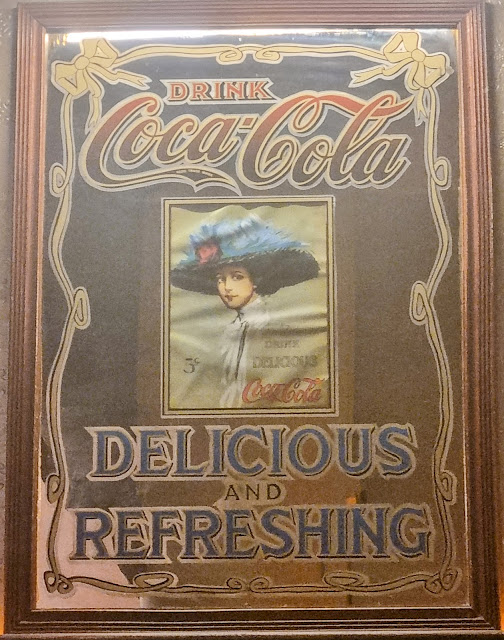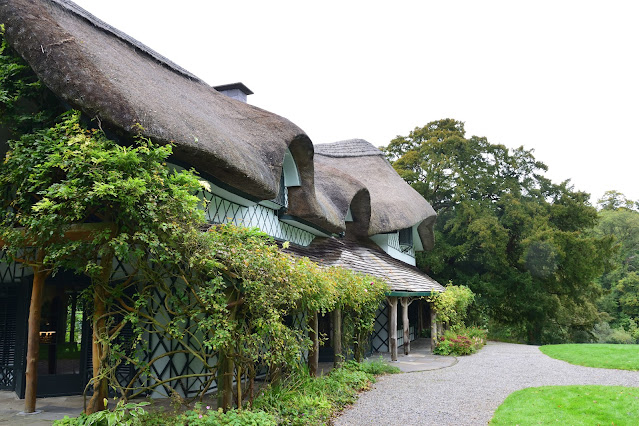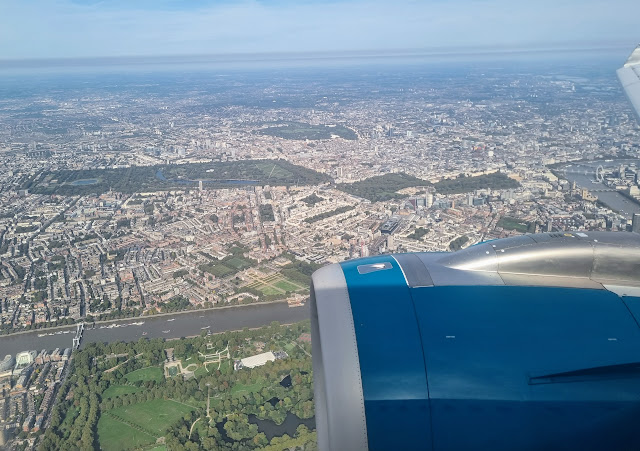Ireland - The Spiritual Home Land
My connection to the Emerald Isle is quite unique with the bloodline predominant on both sides of past generations but none more so than on my mother's side. The township of Clonmel in County Tipperary has the most unique family connection. Two women from what would have been the small village of Clonmel in the 1850's migrated to Victoria (freely) in close proxomity if not together. They were best of friends growing up together. One was a Ryan, the other O'Dwyer. We had a special experience when we last visited Clonmel in 2017 when, by an off chance visit to St Peter & Pauls Catholic Church office located also by chance directly opposite Fennessy's Hotel where we were staying, we caught the Parish secretary as he was locking up. I knew by family records that Johanna O'Dwyer was babtised here snd asked if there would be any records held. With her birth date of 1834 the only clue, the secretary produced a large red leather bound record book , one of dozens, and opened it up to the entries of 1834 whereby we saw the entry of the birth record of my Great Grandmother along with her parents signitures. The most outstanding feature of these entries, at least a 100 per page, was the small, immaculate and consistantly exact hand written cursive writing.
After Mary Ryan's and Johanna O'Dwyers arrival in Victoria it is apparent that they understandably maintained their relationship and mixed in the same but very humble social circles. Mary Ryan was to marry Thomas Holt, my mothers grandparents on her mother's side and Johanna O'Dwyer married James Barron, grandparents on her father's side.
The Irish connection also extends to my fathers side, with his mother's heritage historically Scottish (Crawford), being of Irish decent from County Cork. A large cohort of the Crawford clan migrated to Ireland 2 generations back from his mother being a 1st generation Australian.
It is a real but hard to describe inner sensation of belonging when stepping onto Irish soil. This visit, combined both new and revisited experiences commencing in Dublin and finishing at Laragh in the Wiclow mountains with lots inbetween.
Dublin is a beautiful city but more often than not overrun by 'bloody tourists', not such as ourselfs on this occassion but by AMERICANS! Lots of loud ones. We encountered many through our travels in Ireland and talked with some who were very nice people. We crossed paths at the Guinness Storehouse with a young farming couple with three kids on tow from one of the wheat belt states. He addressed me as'sir' and everything was 'blessed' in that stereo typical southern drawl and I got the impression they were conservative, possibly to the Trump degree, but very nice and interesting to chat with.
DUBLIN
A short flight from Edinburgh with Aer Lingus had a little quirk. After booking the flight and selecting seats there were unusally still some vacant ones up front so I selected row 2. Beauty, quick exit. Boarding our twin engine turbo prop dashed any hope of a quick exit. Entry and exit was from the rear door . Anyway, arrived safely, bus into Dublin and a short walk to our hotel. Dublin now has a recently completed tram system or 'Luas' comprising two lines, red and green, that traverse the city N/S & E/W. It certainly made getting around much easier. Our last visit had us averaging 15 ks a day by foot.
The Home of Guinness Stout, intoduced in 1759, A must with any visit to Dublin
Best pint of Guinness ever poured!
1st of 2 free pints at the home of Guinness. Now an avid Guinness drinker? What have I done!
1st of 2 free pints at the home of Guinness. Now an avid Guinness drinker? What have I done!
Scenes Around Dublin
Irish Museum of Modern Art
Museum grounds and gardens
 Dublin Post Office. Headquarters of the 1917 Easter uprising. The British brought in artillery statiioned in O'Connell Street opposire the PO and all but destroyed it. The building caught fire and all of the births, deaths, marriages and other historical records were kept in the PO and all destroyed. The only source of onformation on record prior to 1917 is with Catholic Parishes. The leaders of the uprising who survived were subsequently executed.
Dublin Post Office. Headquarters of the 1917 Easter uprising. The British brought in artillery statiioned in O'Connell Street opposire the PO and all but destroyed it. The building caught fire and all of the births, deaths, marriages and other historical records were kept in the PO and all destroyed. The only source of onformation on record prior to 1917 is with Catholic Parishes. The leaders of the uprising who survived were subsequently executed.Hill Of Tara and Newgrange Tour
We only spent a short 2 days in Dublin and all of the above was our 1st day. The second day was spent on a full 40 seater bus tour, 35 of which were---?You guessed it. This day was the wettest we encountered for the entire trip and restricted some of the itinerary, particularly the Hill of Tara which was very slippery. These locations are very significant in Irish History. The Hill of Tara is a hill and ancient ceremonial and burial site near Skryne in County Meath, Ireland. Tradition identifies the hill as the inauguration place and seat of the High Kings of Ireland; it also appears in Irish mythology. Newgrange is a prehistoric monument in County Meath in Ireland, located on a rise overlooking the River Boyne, 8 kilometres west of Drogheda. It is an exceptionally grand passage tomb built during the Neolithic Period, around 3200 BC, making it older than Stonehenge and the Egyptian pyramids. Wikipedia
Reference to the River Boyne is itself an important mark in British/Irish history for the military conflict known as the Battle of the Boyne: (July 1, 1690), in British history, a major conflict fought along the Boyne River in Ireland between King William III (William of Orange) and the exiled king James II. Having been deposed and exiled after William’s landing at Brixham and subsequent English desertions, James II sought to retake his throne through an alliance with Ireland and France. A string of Irish Jacobite victories in the northern country were followed by a swift but indecisive loss on the Boyne River. Ref:Britannica via Google.
A continued source of conflict to this day occurs annually in Belfast when loyalist (pro British) groups march through Catholic areas of Belfast celebrating the victory of the Battle of the Boyne.
Mounds above the underground passages at Newgrange-all built around 3200BC
Rock Carvings
Ceremonial placeLast Pub visit for dinner in Dublin
Next Stop Galway
A short 2+hr train journey had us traverse the country from one side to the other albeit at one of the narrowest parts of the Irish Republic being from Dublin to Galway. Only an overnight stay and pick up a rental car for our next 10 days exploring, Galway is a very attractive harbour city and the short train journey allowed us to explore for half a day.
From Galway we headed South down the Atlantic Coast for a scenic 1 1/2 hr drive to Doolin, a small village picked for it's proximity to the Cliffs of Mohr having a full day to explore this section of the Wild Atlantic Coast. It was AFL Grand Final Eve and thankfully our B&B had excellent WiFi to watch the match via live stream through my AFL International Pass at 5.30am the next morning. We headed down latetish afternoon to the closest of the 2 pubs nearby, only a short walk away. We planned to have dinner and stay for the night of folk music. Talking to the publican and two sons who played Gaelic footy, the AFL snuck into the conversation. As it turned out, he has a brother in Sydney who is a keen supporter of the Sydney Swans who, as a consequence, have a keen Doolin supporter. AFL & AFLW are available to watch on a Irish sports channel. My reference to being a Collingwood member resulted in all the usual anti Collingwood banter which had me feeling homesick. PS: As an aside, there would hardly be an Irish family who does not have someone living, or has lived, or is planning to live in Australia.
It wasn't long before the pub was filling up for dinner and the folk night with a good mix of locals and visitors from all over, including from you know where. The background contemporary music, muffled by 'pub noise' was becoming more difficult to recognise as the numbers grew. We were at a table talking to a three women, two were Irish and one a Scot visiting Doolin. Ngaire was holding down most of the conversation and in between I was listening the best I could to the music. Suddenly I thought I was hearing things before the realisation that a very familiar tune was playing------'Good Ole Collingwood Forever' resulting in all sorts of raucus banter and not making much sense to the vast majority except us and another Aussie couple there for the evening. If that wasn't good enough, the encore was----'Ive been everywhere man'.
A most memorable evening of good pub food, a few pints of Guinness, meeting people and live folk music was only topped by a fantastic Grand Final win and exploring more of this terrific part of the country before heading off to the spiritual grounds of Clonmel.
Our Galway hotel from the top
Out and About around Doolin
Views from our B&B
Cliffs of Mohr
Next Stop Clonmel via Clarecastle
It was no coincidence that Clarecastle was a waypoint to Clonmel. We have a very close association with Clarecastle being our local Kapunda pub on the rare occassions thesedays when we frequent it for a pub meal but more so being the venue for our post nuptials reception 23+ years ago.
Unfortunately there is no Clarecastle Hotel in Clarecastle but that is more than made up by it having a magnificent licensed establishment. None other than the:
The sadest misfortune of our passing through was being on a Sunday morning with nothing open because they are all at Mass (thats catholic for going to church). We had one other stop for lunch at Tipperary ( of the song 'it's a longway to Tipperary' fame) which is close to Clonmel.
The town squareLunch. A typical Irish contemporary cafe meal served with a side of crisps?Great to be back in Clonmel-from religionTo politics. Memorial to Clonmel IRA volunteers with a few familiar names
Facade of old mill
River Suir through Clonmel. Irelands 3rd largest river of 185 Kms. Height of river at last visit 2017
Old pubs
Old headstones in a section of preserved original town walls
We utalised our 3 days at Cloinmel to explore some of the historical sights that we could access having the rental car. We utalised the train network during our first visit in 2017 which had it's limitations.
Rock of Cashel :Set on a dramatic outcrop of limestone in the Golden Vale, the Rock of Cashel, iconic in its historic significance, possesses the most impressive cluster of medieval buildings in Ireland. Among the monuments to be found there is a round tower, a high cross, a Romanesque chapel, a Gothic cathedral, an abbey, the Hall of the Vicars Choral and a fifteenth-century Tower House. Originally the seat of the kings of Munster, according to legend St. Patrick himself came here to convert King Aenghus to Christianity. Brian Boru was crowned High King at Cashel in 978 and made it his capital. In 1101 the site was granted to the church and Cashel swiftly rose to prominence as one of the most significant centres of ecclesiastical power in the country."
Cahir Castle :Cahir Castle is one of Ireland's most prominent and best-preserved medieval castles. It is located in County Tipperary and resides on a small rocky island in the middle of the River Suir. The castle was built in 1142 by Conor O'Brien on the remains of an old Irish fortification called a cathair, which is Irish for a stone fort from which the castle derives its name. In 1192, the area around Cahir Castle was granted to Philip of Worchester by John, Lord of Ireland, who would later become King John. The earliest remains of the castle date back to the 13th century. In 1375, the barony of Cahir was passed to James, 3rd Earl of Ormond, head of the great Anglo-Norman Butler family, for his loyalty to Edward III. Most of the present-day Cahir Castle was built during the 15th and 16th centuries by subsequent owners of the Butler family.
Cahir town from the castle

SwissCottage
The best way to access the Swiss Cottage is to park your car at Cahir Castle and take the riverside walk down to it, cross over the bridge and duck into the basement reception area which obstructed the view of the servants who would bring over the food and supplies for the day, as nobody actually ever spent the night there (we drove). Designed and built by the famous Regency architect John Nash, it was commissioned by Richard Butler, the 1st Earl of Glengall (of Cahir Castle), as an idyllic pastoral retreat, similar to the Trianon in Versailles, to be used in the Summertime. No expense was spared in building or furnishing this thatched and rose covered ‘cottage orné’ or folly.
Only the finest furnishings, specially made for the cottage, hand painted murals and the most expensive wallpaper in the world at the time, made by Dufour in Paris, were used to complete the fantasy which remained in use for a relatively short period of time until it was abandoned and the animals took over. Saved by an American lady Sally Aall (rip) who collaborated with the Irish Georgian society, it was completely restored and is now as good as new and so delightful you could imagine yourself moving in right away.The cottage was built purely as a status symbol used to host garden parties for the Butler's friends and other upper class connections.
Saint Patricks Well
Saint Patricks Well is situated in a tranquil valley to the west of Clonmel, close to the village of Marlfield in County Tipperary. It is a picturesque setting for this holy site, which has been revered for centuries. There are over 3,000 holy wells in Ireland and St Patrick’s Well is thought to be one of the largest. Holy wells are sacred places where natural springs or man-made hollows that collect water are thought to have a religious significance because of their association with a saint. Many are thought to have been originally places of pre-Christian worship and tradition which were then co-opted as Christian sites following the conversion of the local population. Legend has it that St Patrick stopped off at this valley on his journey through South Tipperary and Waterford where he reputedly converted the King of Munster to Christianity at the Rock of Cashel.
Ormonde Castle
Ormonde Castle, located in the picturesque town of Carrick-on-Suir, has a complex and intriguing history that dates back to the 13th century. The first mention of the castle can be traced to 1309, when it was initially a stronghold of the powerful Butler family. Over time, this medieval fortress underwent several transformations and expansions, resulting in the magnificent structure that stands today. The original Ormonde Castle was a formidable, square-shaped structure built using local limestone. It featured a central courtyard, surrounded by high curtain walls, and a substantial tower on each corner. These towers played a crucial role in the castle’s defense, providing a vantage point for guards to survey the surrounding countryside and River Suir. The 18th and 19th centuries were challenging times for Ormonde Castle, as the Butler family faced financial difficulties and a decline in power. Eventually, the castle fell into disrepair and was abandoned. Over the years, it became a shadow of its former glory, with parts of the structure crumbling and the once-lavish gardens left untended. Thankfully, the 20th century brought renewed interest in the preservation of Ireland’s historical landmarks, including Ormonde Castle, Tipperary. The Irish government acquired the castle in 1947, and a significant restoration project began to return the castle to its former grandeur. This painstaking work involved repairing the delicate plasterwork, restoring the woodcarvings, and revitalizing the castle’s gardens. In 1993, Ormonde Castle was officially opened to the public, allowing visitors to experience its rich history and breathtaking architecture.
The Long Room. The Stucco on walls and ceilings is the oldest surving of it's kind
Butler Family Crest Above The Fireplace
Attic Timbers restored to the original craftsman ship
Tudor Manor House Attached to The Front of Ormonde Castle
Final Destination-Wiclow/Laragh/Glendalough
This visit to Wicklow Mountains National Park and the Hisrotic Manastic Village of St Kevins at Glendalough was inspired when we visited here as one stop on a day bus tour in 2017. We had decided then that if we returned to Ireland we would come back here for a couple of days. Glendalough is home to one of the most important Monastic sites in Ireland surrounded by the most picturesque countryside. This early Christian Monastic settlement was founded by St. Kevin in the 6th century and from this developed the “Monastic City”. Most of the buildings that survive today date from the 10th through 12th centuries. Despite attacks by Vikings over the years, Glendalough thrived as one of Ireland’s great ecclesiastical foundations and schools of learning until the Normans destroyed the monastery in 1214 A.D. and the dioceses of Glendalough and Dublin were united.
It was in this vicinity that the battle scenes in the Braveheart movie were filmed along with other locations in Ireland. Why in Ireland for a Scottish historical movie? Primarily because Mel Gibson who starred in, produced and directed the movie has dual Irish citizenship and uses Irish locations in his film making.
Post Script
Our journey back home commenced here on Sunday October 8 with an early start to return the rental car to the airport office then breakfast at Dublin Airport and a late morning flight to London. Short visit to the British Airways Lounge at Heathrow for lunch before a 1530 70 min hop to Paris then dinner and bed at a Airport Hotel. Another travel first notched up. Breakfast, lunch then dinner in 3 countries.
Approaching Heathrow. Notice the arch above the dome roof which highlights Wembley Stadium
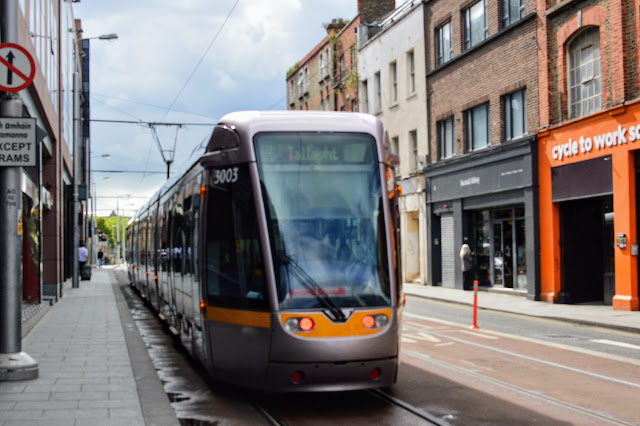


.JPG)














